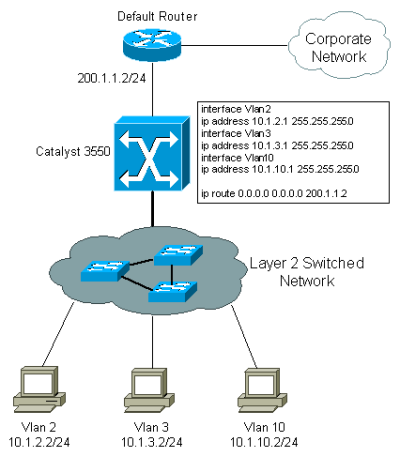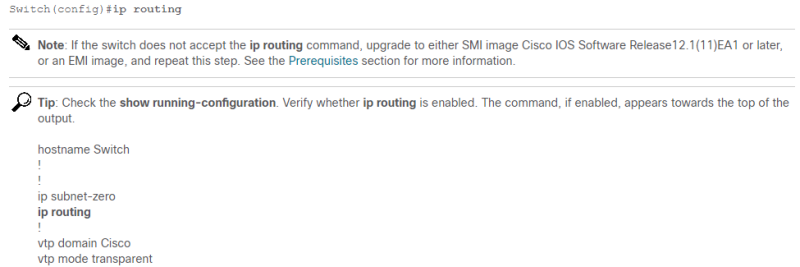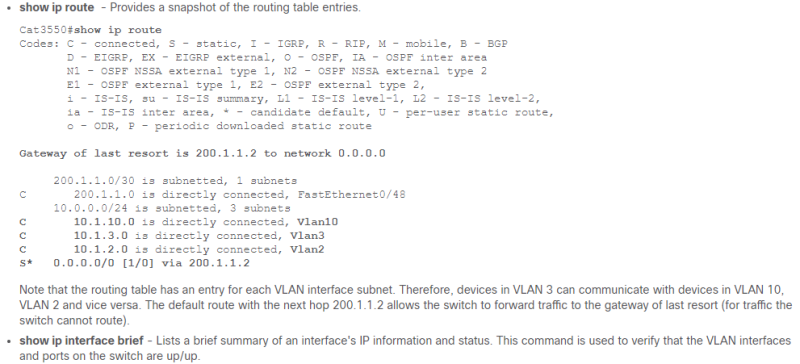Table of Contents
CONFIGURE INTERVLAN ROUTING ON LAYER 3 SWITCHES
Introduction
This document provides the configuration and troubleshooting steps applicable to the creation of Layer 3 interfaces. VLANs divide broadcast domains in a LAN environment. Whenever hosts in one VLAN need to communicate with hosts in another VLAN, the traffic must be routed between them. This is known as inter-VLAN routing. On Catalyst switches it is accomplished by the creation of Layer 3 interfaces (switch virtual interfaces (SVIs) ).
Prerequisites
Requirements
Catalyst switch models 3560, 3750, Catalyst 4500/4000 Series with Sup II+ or later, or Catalyst 6500/6000 Series that run Cisco IOS system software support basic InterVLAN routing features in all their supported software versions. Before you attempt this configuration on a 3550 series switch, ensure that you meet these prerequisites:
InterVLAN routing on the Catalyst 3550 has certain software requirements in order to support interVLAN routing on the switch. See this table in order to determine whether your switch can support interVLAN routing.
Components Used
The information in this document is based on a Catalyst 3550-48 that runs Cisco IOS Software Release 12.2(44)SE6 EMI.
The information in this document was created from the devices in a specific lab environment. All of the devices used in this document started with a cleared (default) configuration. If your network is live, make sure that you understand the potential impact of any command.
Configure InterVLAN Routing
Task
In this section, you are presented with the information to configure the features described in this document.
This logical diagram explains a simple interVLAN routing scenario. The scenario can be expanded to include a multi-switch environment if you first configure and test inter-switch connectivity across the network before you configure the routing capability.
Step-by-Step Instructions
Complete these steps in order to configure a switch to perform interVLAN routing.
1. Enable routing on the switch with the ip routing command. Even if IP routing was previously enabled, this step ensures that it is activated.
2. Make note of the VLANs that you want to route between. In this example, you want to route traffic between VLANs 2, 3 and 10.
3. Use the show vlan command in order to verify that the VLANs exist in the VLAN database. If they do not exist, add them on the switch. This example shows the addition of VLANs 2, 3, and 10 to the switch VLAN database.
4. Determine the IP addresses you want to assign to the VLAN interface on the switch. For the switch to be able to route between the VLANs, the VLAN interfaces must be configured with an IP address. When the switch receives a packet destined for another subnet/VLAN, the switch looks at the routing table in order to determine where to forward the packet. The packet is then passed to the VLAN interface of the destination. It is in turn sent to the port where the end device is attached.
5. Configure the VLAN interfaces with the IP address identified in step 4.
6. Configure the interface to the default router. In this scenario you have a Layer 3 FastEthernet port.
7. Configure the default route for the switch.
8. Configure your end devices to use the respective Catalyst 3550 VLAN interface as their default gateway. For example, devices in VLAN 2 should use the interface VLAN 2 IP address as its default gateway. Refer to the appropriate client configuration guide for more information on how to designate the default gateway.
Verify
Troubleshoot
This section provides the information used in order to troubleshoot your configuration.
Troubleshooting Procedure
Here is troubleshooting information relevant to this configuration. Follow the instructions in order to troubleshoot your configuration.
1. Issue Internet Control Message Protocol (ICMP) pings in order to verify whether you have Layer 2 connectivity.
- If you are not able to ping between two devices on the same VLAN on the same switch, verify that your source and destination ports have devices connected to them and are assigned to the same VLAN. For more information, refer to Creating Ethernet VLANs on Catalyst Switches.
- If you are not able to ping between two devices on the same VLAN but not on the same switch, verify that trunking is configured properly and that the native VLAN matches on both sides of the trunk.
2. Initiate an ICMP ping from an end device connected to the Catalyst 3550 to its corresponding VLAN interface. In this example, you can use a host on VLAN 2 (10.1.2.2) and ping interface VLAN 2 (10.1.2.1). If you are not able to ping the interface, verify that the host's default gateway points to the corresponding VLAN interface IP address and that the subnet masks match. For example, the default gateway of the device on VLAN 2 should point to Interface VLAN 2 (10.1.2.1). Also verify the interface VLAN status by issuing the show ip interface brief command.
- If the interface status is administratively down, enter the no shutdown command in the VLAN interface configuration mode.
- If the interface status is down/down, verify the VTP configuration and that the VLANs have been added to the VLAN database. Check to see if a port is assigned to the VLAN and whether it is in the Spanning Tree forwarding state.
3. Initiate a ping from an end device in one VLAN to the interface VLAN on another VLAN in order to verify that the switch routes between VLANs. In this example, ping from VLAN 2 (10.1.2.1) to Interface VLAN 3 (10.1.3.1) or Interface VLAN 10 (10.1.10.1). If the ping fails, verify that IP routing is enabled and that the VLAN interfaces status is up with the show ip interface brief command.
4. Initiate a ping from the end device in one VLAN to the end device in another VLAN. For example, a device on VLAN 2 should be able to ping a device on VLAN 3. If the ping test is successful in step 3, but fails to reach the end device on the other VLAN, verify that the default gateway on the connected device is configured correctly.
5. If you are not able to reach the Internet or corporate network, verify that the default route on the 3550 points to the correct IP address on the default router. Also verify that the IP address and subnet mask on the switch are configured correctly.
There is no set recommended value of bandwidth on a VLAN interface (SVI). The default is BW 1000000 Kbit (1 Gigabit), because the route processor internal inband is only 1 Gigabit by design. The bandwidth parameter on the show interface vlan output is not fixed bandwidth used by SVI as traffic is routed on the switch backplane. The bandwidth number can be used in order to manipulate routing metrics, calculate interface load statistics, and so forth.
The Catalyst 6500 switch platform mostly forwards traffic in hardware with the exception of control/special traffic, for example, SNMP, Telnet, SSH, Routing protocols, and ARP, which has to be processed by the Supervisor, which is done in the software.








